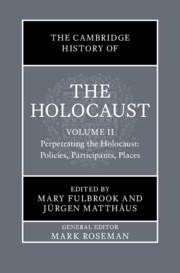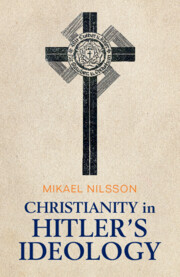Refine search
Actions for selected content:
60 results
15 - The German Home Front
- from Part V - Home Fronts
-
-
- Book:
- The Cambridge Companion to the Nazi-Soviet War
- Published online:
- 13 November 2025
- Print publication:
- 20 November 2025, pp 265-280
-
- Chapter
- Export citation
The Nazi Financial Order: Banking Law and the Credit Supervisory Office in Germany and Austria
-
- Journal:
- Central European History , First View
- Published online by Cambridge University Press:
- 05 September 2025, pp. 1-27
-
- Article
-
- You have access
- Open access
- HTML
- Export citation
Conclusion: What We Talk About When We Talk About Roman Law
-
- Book:
- The God and the Bureaucrat
- Published online:
- 17 July 2025
- Print publication:
- 31 July 2025, pp 292-302
-
- Chapter
- Export citation
16 - Change and International Legitimacy
- from Part V - International Legitimacy and Change
-
- Book:
- The Law and Politics of International Legitimacy
- Published online:
- 14 July 2025
- Print publication:
- 24 July 2025, pp 301-317
-
- Chapter
- Export citation
3 - Conflicts of Interest
-
- Book:
- Spinning the World
- Published online:
- 03 July 2025
- Print publication:
- 24 July 2025, pp 62-81
-
- Chapter
- Export citation
Chapter 5 - Groups of Prejudice and Intolerance
- from Section 1 - Typology
-
-
- Book:
- A Clinical and Forensic Guide to Cults and Persuasive Leadership
- Published online:
- 19 June 2025
- Print publication:
- 03 July 2025, pp 87-117
-
- Chapter
- Export citation
4 - Angular and Career Momentum: What Lucy Mensing Contributed to Physics and Why She Left the Field
-
-
- Book:
- Women in the History of Quantum Physics
- Published online:
- 02 July 2025
- Print publication:
- 19 June 2025, pp 102-148
-
- Chapter
- Export citation

The Cambridge History of the Holocaust
-
- Published online:
- 21 May 2025
- Print publication:
- 12 June 2025
2 - Survivors
-
- Book:
- Making Do
- Published online:
- 24 April 2025
- Print publication:
- 24 April 2025, pp 56-96
-
- Chapter
- Export citation
Learning Forced Migration: Guidance for Prospective Jewish Refugees in Nazi Germany
-
- Journal:
- Central European History / Volume 58 / Issue 1 / March 2025
- Published online by Cambridge University Press:
- 13 March 2025, pp. 25-45
- Print publication:
- March 2025
-
- Article
-
- You have access
- Open access
- HTML
- Export citation
2 - A Theory of People’s Factual Beliefs and Credulity in War
-
- Book:
- Seeing Is Disbelieving
- Published online:
- 31 August 2024
- Print publication:
- 21 November 2024, pp 18-52
-
- Chapter
- Export citation
2 - Ludwig Erhard, Who Took Credit for Edward A. Tenenbaum’s Success
-
- Book:
- Edward A. Tenenbaum and the Deutschmark
- Published online:
- 19 October 2024
- Print publication:
- 31 October 2024, pp 11-93
-
- Chapter
- Export citation

Christianity in Hitler's Ideology
- The Role of Jesus in National Socialism
-
- Published online:
- 31 August 2024
- Print publication:
- 27 June 2024
3 - Christ on the Crooked Cross, Part II
-
- Book:
- Christianity in Hitler's Ideology
- Published online:
- 31 August 2024
- Print publication:
- 27 June 2024, pp 134-159
-
- Chapter
- Export citation
Conclusion
-
- Book:
- Christianity in Hitler's Ideology
- Published online:
- 31 August 2024
- Print publication:
- 27 June 2024, pp 234-242
-
- Chapter
- Export citation
1 - Christ on the Crooked Cross, Part I
-
- Book:
- Christianity in Hitler's Ideology
- Published online:
- 31 August 2024
- Print publication:
- 27 June 2024, pp 32-84
-
- Chapter
- Export citation
5 - Jesus as an Ideological Inspiration for Hitler and the NSDAP
-
- Book:
- Christianity in Hitler's Ideology
- Published online:
- 31 August 2024
- Print publication:
- 27 June 2024, pp 180-233
-
- Chapter
- Export citation
Introduction
-
- Book:
- Christianity in Hitler's Ideology
- Published online:
- 31 August 2024
- Print publication:
- 27 June 2024, pp 1-31
-
- Chapter
- Export citation
2 - Hitler’s Religious Teachers
-
- Book:
- Christianity in Hitler's Ideology
- Published online:
- 31 August 2024
- Print publication:
- 27 June 2024, pp 85-133
-
- Chapter
- Export citation
Carl Schmitt and Ossip Flechtheim at Nuremberg: A Crossroads for International Justice and Intellectual History
-
- Journal:
- German Law Journal / Volume 25 / Issue 4 / June 2024
- Published online by Cambridge University Press:
- 29 April 2024, pp. 597-634
-
- Article
-
- You have access
- Open access
- HTML
- Export citation
